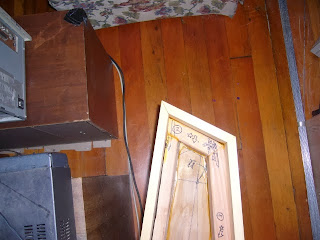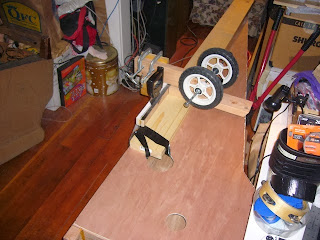So now I have all of the sides glued on. There are a couple areas that need additional gluing, probably with this hypothetical filler compound of glue and sawdust, which I have yet to try. And I will have to fashion thin wedges of wood to glue into some voids, where my cut wandered in trimming the frame. Most concerning is at the wrestplank end of the spine timber. I hope I can fashion a tight-fitting wedge, glue it into the void next to the wrestplank, while gluing the wrestplank itself into position, and using the clamping to correct some of the outward cupping on the bottom of the spineside case plank: all in the same operation.
Before gluing in the wrestplank, I will drill holes in the nut for the pins (nails), and attach the nut. And I will drill pilot holes for the tuning pins, with the drill press, so that I can drill the full-size holes with the handheld drill later on; I could probably maneuver the drill press to work on the wrestplank after it's glued into the frame, but I hope to thus avoid doing that.
Here, the pieces are just placed in position, in the frame. You can see my relatively-narrow 2-inch gap, between the wrestplank and the soundboard. As I am designing the action, I can see it will be tight to fit this spacing. At this point, I could still choose to make it wider, by fitting spacer blocks when I glue in the wrestplank: ugly, but I think it'd be strong in the right ways. But, I want to try to target a 2" gap. This will allow the action to still work with higher notes than I have here, such as instruments with a 4-foot choir (a set of strings 1 octave higher on each note).
The two elements that need space in the gap are the strikers, and the dampers. The dampers will be vertical wires, passing through holes in a narrow rail, and bent into loops at the top to which felt will be glued. These come from underneath and press against the strings. The damper rail will be closest to the soundboard, in the gap. I'm pretty sure I can build it to occupy less than half of the gap, probably about a third overall, max.
So the strikers will have more than an inch of front-to-back space in the gap, which seems like it ought to be enough. However, there are complicating factors. The strikers on this action will necessarily be quite tall, something near 2" (which brings in a host of concerns in itself, as to stability and dynamic behaviour vis a vis the different guide systems in the action -- but presumably I will somehow solve all this and make the strikers work right). Since the motion of the key is circular, centered on a pivot-point something like 12" away from the striker, the striker moves through a shallow arc, and thus needs more than its own size worth of clearance, towards the front (wrestplank side). And given the intentional "looseness" of the guide situation, the strikers will need more clearance generally, to ensure no-contact with other elements. (Unlike other early "tangent pianos" where the strikers moved vertically in harpsichord-like guides, in my action design, the strikers are more or less firmly associated with their keylevers, and follow their motion: the guides for the strikers are attached to the keylevers.)
And the real complicating factor is, the moderator stop. This is a little strip of cloth, felt, or leather (haven't decided which material yet, will probably have to try them on the real instrument before deciding: just hope I don't decide I want all the types available as separate stops!), which can slide into position between the strikers and the strings, thus softening the tone of the bare-wood strikers. The effect is as if the strikers themselves were covered with the moderator material. It's important that the moderator fabric not touch the strings, except when and where a striker has been keyed: when playing with the moderator active, the strings still have their full sustain time, it's just a softer initial excitation; this is in contrast to the "buff" stop, where the strings themselves are muted and have a much-reduced sustain time.
Doing without a full set of tone-modifying gadgets is simply out of the question for me, in-style or not. So the question is, how can I fit the moderator into all this? Specifically, where will it "stow" itself, when not in use? The obvious design for the moderator is a long rail or rod, with the fabric attached along its edge and protruding to one side. The rail itself does not pass through the path of the strikers, but it moves up close to the strikers, so that the fabric is in their path, or it moves farther away "somewhere", so that the fabric is out of the way of the strikers. The simple plan would be for the rail to slide horizontally (or move through a wide arc, approximating a horizontal slide), so that when not deployed, the moderator would be taking up its full width of space next to the strikers, in front or in back. However... The moderator can't slide to the back, because that's where the dampers are. (Original pandalons didn't have conventional per-note dampers, so if I were sticking to that exact design concept, I wouldn't have a problem here, but like I said, every possible gadget... The per-note dampers are particularly important to me: I want to be able to play with articulation, and also to play with the dampers off. Not many instruments prior to the piano (which has its own problems of course, or I wouldn't be here) gave both options in one instrument, but we don't have to be limited by the past to learn from it.) And to the front, i.e., between the striker-zone and the nut, will be the rails of two other stops, the buff and the bassoon. I'm not positive, but I don't think there will be room to park the moderator in the space that remains. So, I'm considering making the moderator swing through an angle of 90 degrees, and slip down in between the strikers and the dampers, in a vertical orientation. I think there may be just the right amount of room for the required arc of motion to do this, since the strikers in rest position sit well below the strings. We'll see, there's plenty of time for me to pull together the exact design of all the stops and gadgets, because I will finish building the full basic instrument first, before I start on these other things.
Pretty pointy. I recently had the opportunity to see if the instrument will likely fit in my friend's car, an early-2000's Toyota wagon. It will be very convenient if I can fit into this very-typical vehicle, and conversely, it will be very inconvenient if I can't! The car was parked at my apartment the other day, so we carried out the big piece of plywood you can see standing up off to the side (at the bottom of the photo). This will become the lid of the instrument, and it is already cut to the rough outline, so it's a good representation of the footprint. And, with all the seats down, we found that the lid piece fits very nicely in the car -- although, given our driver-on-the-left country, it fits best upside down! I guess that won't hurt anything... Presumably the real instrument will be encased in a "sleeping bag" I'll make for it, stitched-together out of blankets.
However, we weren't figuring on the additional length of the keyboard and action, which (I'm pretty sure) will extend the length even farther than any of the current wood. I'm planning to make the action easily-removeable anyway; perhaps it may be necessary to separate the action from the instrument, every time I want to move it somewhere. Maybe that's better anyway: there may be reasons I don't want the action to spend hours bumping around in the back of a car, while in the upside-down position.





























